replication of RNA viruses I
2/05
Last week went over DNA ss, ds, and ds with reverse transcription
Today/wed will go over RNA viruses
refresh on replication
DNA -> replication (dna polymerase) -> more DNA
DNA -> transcription (rna polymerase) -> mRNA
mrna -> translation (ribosomes in cytoplasm) -> protein
in RNA viruses, both replication and transcription use RNA templates (both are RNA-dependent)
- only RNA genome
- use RNA replicates, so must be RNA dependent
review of DNA transcription
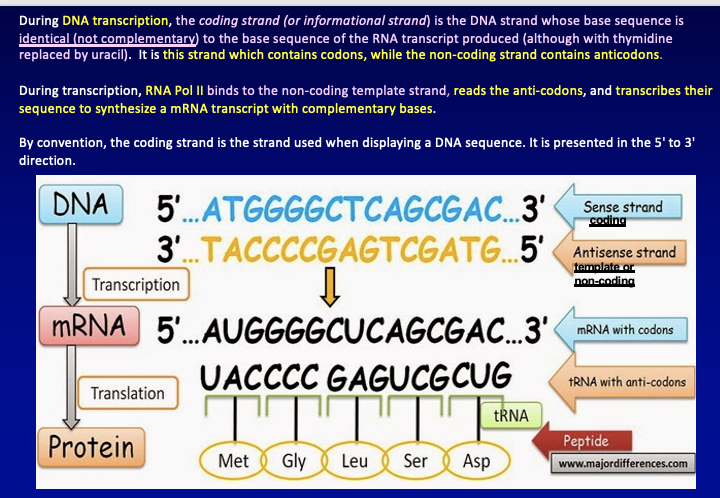
didnt go over this
general properties of RNA virus
- is labile and transient
- DNA is NOT. DNA is more stable
- most RNA
replicate in cytoplasm
- DNA usually replicate in nucleus (except poxvirus)
- cells cannot replicate RNA, thus all RNA viruses (except retroviruses) must encode an RNA dependent RNA polymerase (replicase and transcriptase)
- genome structure determines mechanisms of transcription/replication
- RNA viruses highly prone to mutations and lack proofreading activity (higher mutation rate and less stability/higher polymerase activity)
- majority of human viral pathogens are RNA viruses
host cell imposes constraints on RNA viruses
- cell produces its own mRNA in nucleus (transcription of its own
DNA)
- cell does DNA -> RNA (DNA dependent RNA polymerase)
- cells infected by RNA viruses lack enzymes to make mRNA from viral RNA genome (the cell itself cannot do this)
- thus, RNA viruses
had to develop their own enzymes to generate mRNA
- viral RNA dependent RNA polymerase (RdRp)
what do enzyme do RNA viruses have to generate mRNA?
viral RNA dependent RNA polymerase
in order to make RNA from RNA, bc cell itself only carries DNA dependent RNA polymerase normally
mRNA
identical to coding DNA strand
complementary to template DNA strand
mRNA configuration
plus (+) configuration
mRNA's complement
minus (-) configuration
ss RNA genome same as mRNA is
+ strand rna virus
ss RNA virus genome complementary to its mRNA
- strand RNA virus
Based on relationship btw genomes of viruses and mRNA
mRNA by definition = coding strand (remember from before)
- complementary to template strand in DNA
So mRNA = (+) configuration (+ RNA)
And mRNA’s complement has (-) configuration
Virus w/ ssRNA genome in same orientation as its mRNA is called a + strand RNA virus
So + rna viruses are ready to translate
= they immediately infect you, they do not need anything in order to translate except the cell functioning (what I said myself)
- strand RNA viruses go thru diff mechanism, they do not directly translate (they must first transcribe)
what kind of virus is covid?
+ RNA virus
+ strand mRNA have genomes that are
functional
- bc they can translate themselves directly, dont need to transcribe
2 groups of RNA viruses whose genomes are NOT mRNAs
- (-) strand RNA viruses
- DS RNA viruses
for these, 1st event after genome penetration is transcription
- done by viral proteins (like RdRp) that enter cell together with genome in virion particle
which RNA virus does NOT bring RdRp with it into the host cell?
(+) RNA, bc just coding for RdRp is sufficient, since it can directly translate and make proteins after entering cell
- thus, it will make RdRp after it translates
what RNA virus DOES bring RdRp with it into the host cell?
(-) strand and DS RNA viruses, because they require RdRp for initial TRANSCRIPTION of (-) strand to make mRNA (+) after entering the cell
- their first event in the cell is transcription, so they need to bring RdRp in order to be able to
4th group of RNA viruses = retroviruses
+ mRNA that contain mRNA genomes, but DO NOT TRANSLATE THEIR mRNA
-> reverse trancsription
- 4th group – retroviruses - are + strand RNA viruses - they don’t translate - do reverse transcription (RNA -> DNA)
viruses are classified regarding "sense' of their RNA
- (+) - viral genome can be directly used as mRNA
- (-) - viral genome must first be transcribed into mRNA
RNA viruses that DONT use DNA intermediate
- virus containing mRNA in their genome
- they first translate
- those that dont (-
strand RNA, ds RNA)
- they first transcribe
- - strand RNA
- and
- ds RNA
- viruses
- do not carry mRNA as genome
- require viral-encoded transcriptases contained in their virions
- virion genomic RNA = template for transcription, not translation
Only + strand can translate
Other 2, transcribe
Retrovirus exception ( use DNA as intermediate)
retroviruses
exception to written above
carry mRNA genome
BUT use DNA as intermediate in their replication
...
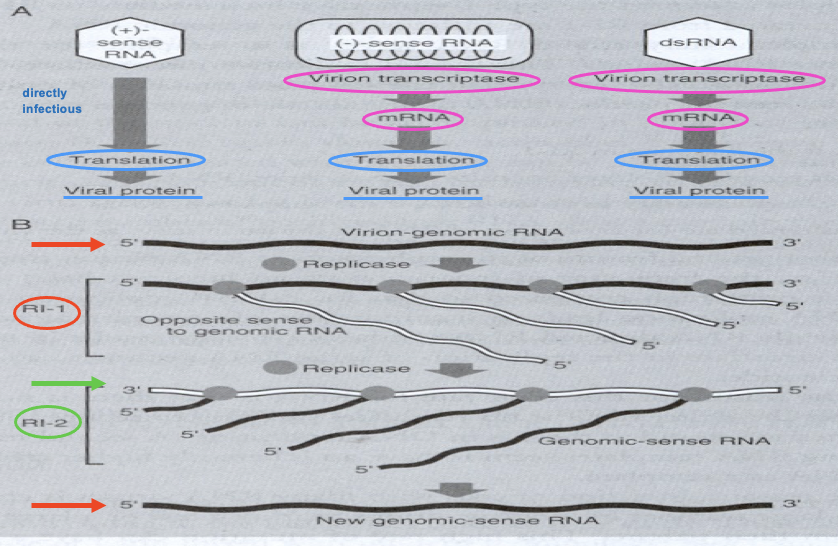
- and ds rna are NOT immediately infectious like the + rna is (bc it directly translates)
Replicase uses original genome as template to produce mRNA (make RNA of opposite sense, so - produce + and + produce - rna)
- these intermediate RNAs serve as templates
ssRNA virus genome replication
requires 2 stages
(w/ exception of retrovirus)
-
input strand
- transcribed into complementary sequence of opposite polarity, type 1 replicative intermediate (RI-1)
- ->
this complementary strand
- template for formation of genomic-sense RNA strand (type 2 replicative intermediate, RI-2)
Mechanism of replication
Input -> complementary strand -> make more of original strand using complementary strand (I think this is what last slide showed too)
thus
- virion RNA is the template in RI-1
- RI-1 produce RNA of opposite sense to virion RNA
- RNA that is complementary to virion RNA is template in RI-2
- RI-2 is intermediate for expression of RNA of the same sense of the virion
RNA virus replication -> error frequency of RNA-directed replication -> quite high compared to DNA
- mismatch base incorporation in DNA is 10^-7 to 10^-9
- mismatch base incorporation in RNA is 10^-4 to 10^-5
- also no proofreading or editing repair in RNA like there is in DNA
- thus, infection of cells w/ RNA viruses can lead to generation of defective/mutated viruses -> significant role in viral pathogenesis and evol
RNA virus replication has high frequency for mistakes
- much more than DNA
picorna viruses
(+) sense RNA viruses
polio, common cold, Hep A
togaviruses
(+) sense RNA viruses
rubella
flaviviruses
(+) sense RNA viruses
yellow fever, Hep C, dengue
coronaviruses
(+) sense RNA viruses
COVID, SARS, MERS, common cold
HTLV, HIV
retroviruses
HTLV is oncogenic -> leukemia in humans
paramyxoviruses
(-) sense RNA viruses
measles, mumps, RSV
rhabdoviruses
(-) sense RNA viruses
rabies
orthomyxoviruses
(-) sense RNA viruses
flu
bunyaviruses
(-) sense RNA viruses
resp distress hemorrhagic fevers
reoviruses
DS RNA viruses
resp/GI infections
ADD PIC
Rna viruses can be enveloped or naked
Enveloped
- ss genome
- segmented (can do reassortment)
- flu
- nonsegmented
- MMR, rsv
- rabies
- ss reverse transcriptase
Nonenveloped
- ssrna
- picornavirus
- ds rna
-reoviruses
(+) strand RNA viruses
- (+) RNA strand which is = mRNA
- infectious
- can be capped/polyadenylated
- ex: some RdRps make mRNA caps and make poly A mRNAs
- this (+) RNA encodes -> virus specific RNA-dependent RNA polymerase (RdRp)
- RdRp is NOT already present bc not needed IN the virion - it is created by the viral mRNA
- mRNA bind ribosomes -> viral proteins
- translation -> polyproteins -> post translationally cleaved into diff proteins w/ viral proteases
- after RNA polymerase is created by the viral mRNA
- ->
(-) strand RNA template (RI) is
made
- RNA template - generates more mRNA + to replicate viral genome
- ->
(-) strand RNA template (RI) is
made
Not in virion bc directly infectious, so it makes it (protein)
- after RNA pol translated, the (-) template is made, as a template to make more mRNA + replicate genome
what is RNA-dependent RNA polymerase?
the enzyme ENCODED by (+) RNA viruses
- created when the (+) RNA is directly translated (on host cell ribosomes) to make the proteins and cleaved = gives rise to this polymerase
- not in viron bc not required for mRNA translation
- used for replication of viral RNA
- this and other viral proteins are needed for viral RNA synthesis
- encoded as polyprotein that is cleaved by virally encoded proteases
(+) RNA functions
- acts as mRNA -> directly translate to make viral proteins
- serve as template for replication to make more viral RNAs
(+) RNA viruses are translated when?
directly/right away
shortly after penetration into the cell
ex: polio
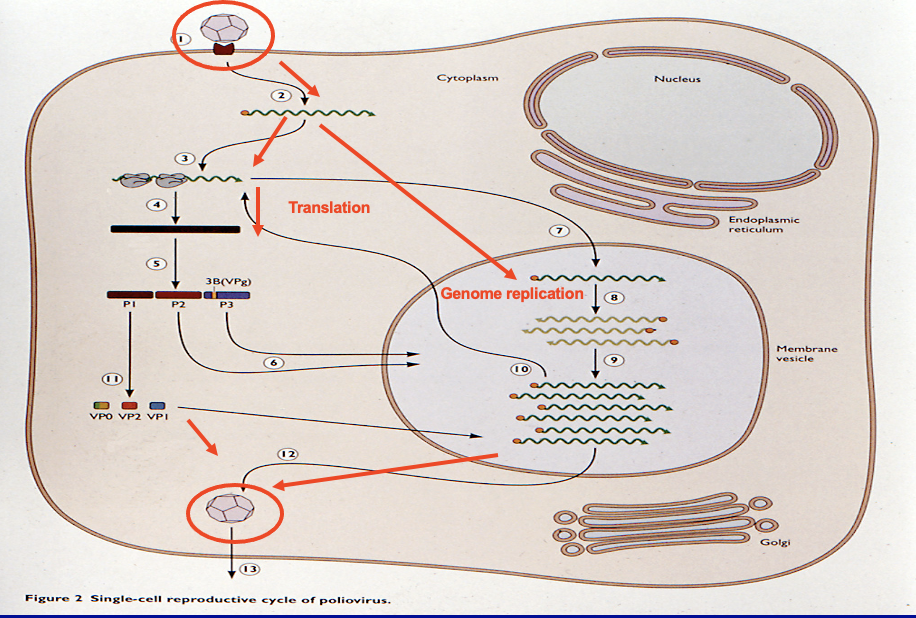
Example of how this happens in polio
1.virion release the mRNA into host cell
2.Go directly to ribosomes to translate
3.Then cleaved by proteases
4.In nucleus, viral mRNA do genomic replication
5.Exit membrane (mRNA) w/ capsid proteins and etc. all formed correctly
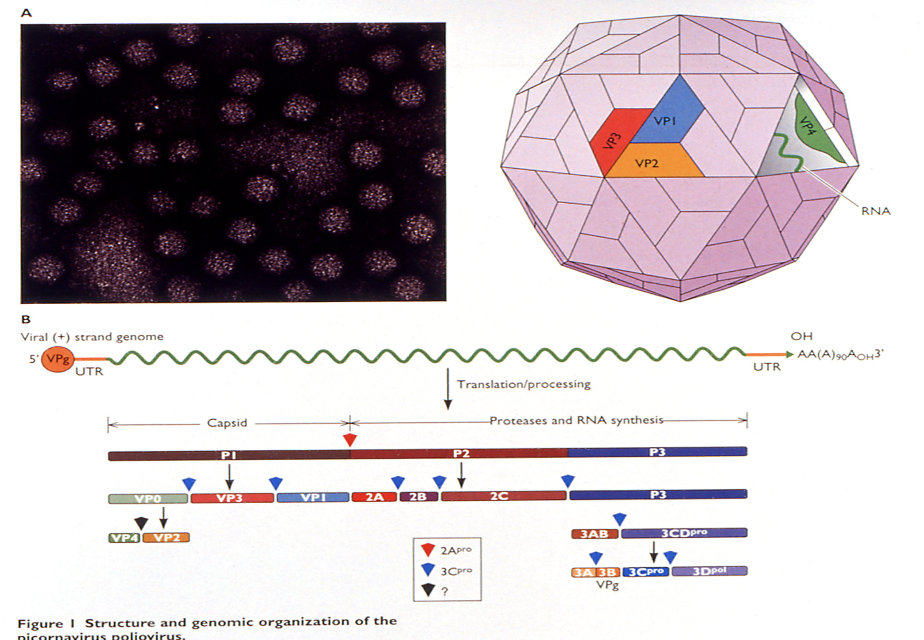
proteins made by (+) mRNA and what they do
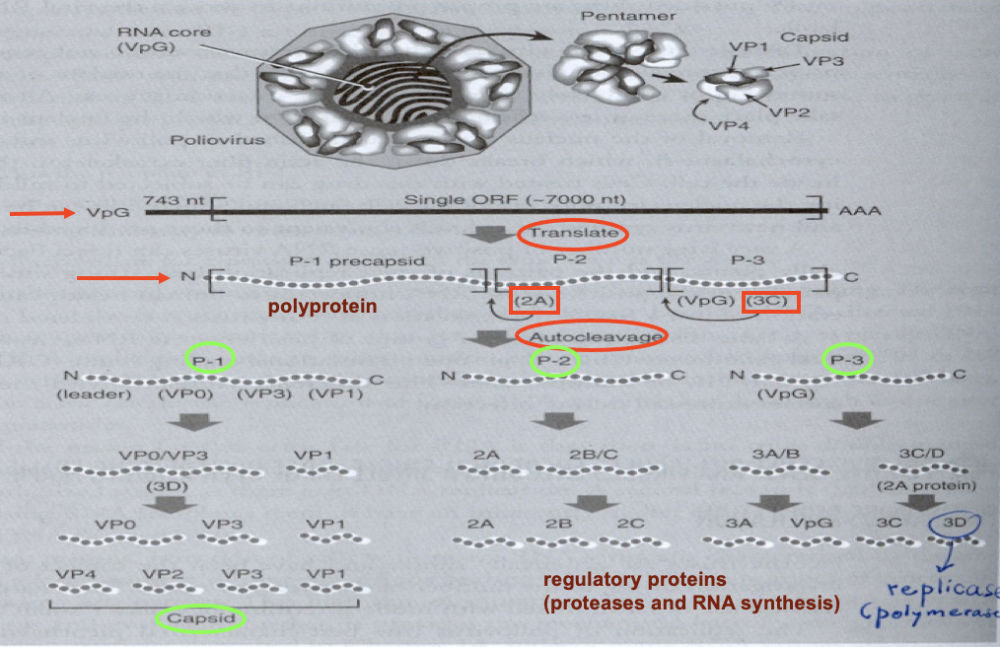
Block synth of host cell proteins
Don’t have 5’ cap, but have “ VpG” - allows virus to stop synth of host cell proteins
Translation -> make polyprotein
- produced thru autocleavages (see proteases 3C and 2A)
= make P1, P2, P3
- P1 -> capsid proteins
- P2/P3 make other regulatory proteins
steps in assembly of poliovirus capsid
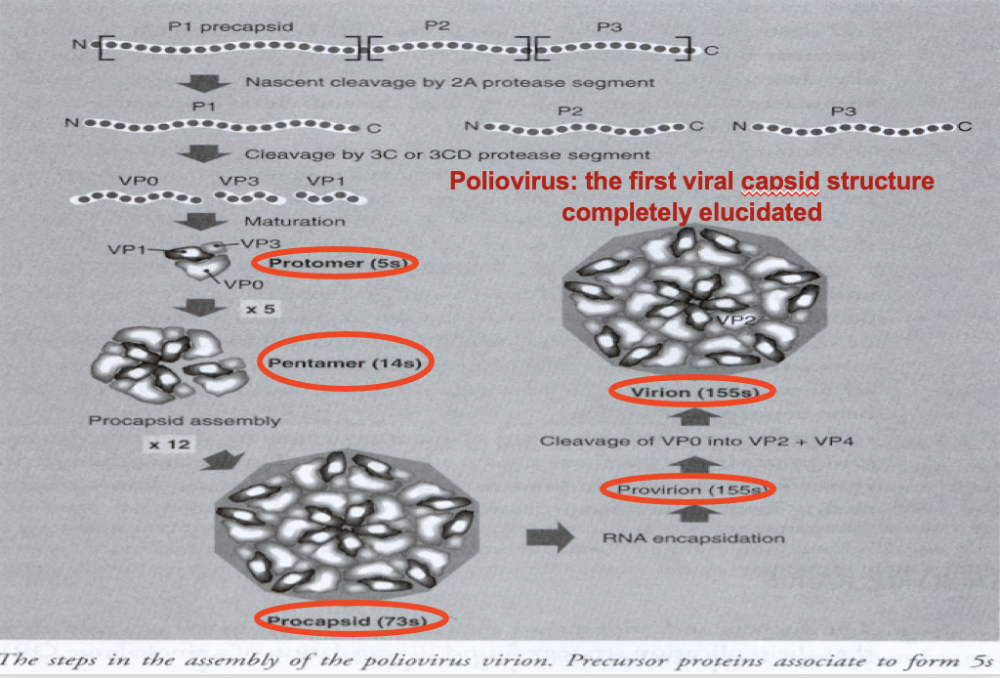
Polio virus – 1st viral capsid completely elucidated in structure
Capsid proteins assemble into protomer, then pentamer, then procapsid, provirion, then virion
how (+) RNA viruses shut down cellular protein synthesis
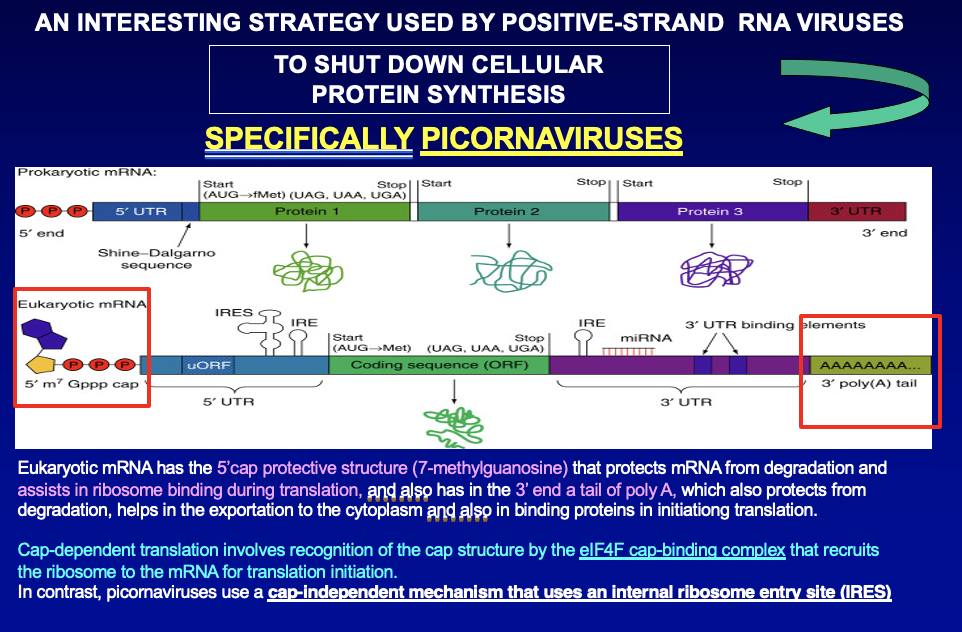
cellular mRNA has 5' cap to protect from degradation + assist ribosomal binding in translation and has 3' end poly A tail, also protects from degradation
cap-dependent translation involves recognition of cap structure by elF4F cao-binding complex that recruits ribosomes to the mRNA for translation initiation
but, (+) RNA (like picornaviruses) - use cap-independent mechanism to use internal ribosome entry sites (IRES)
Used by many RNA viruses
5’ cap structure – allow recognition by ribosome (cap recognition site allow binding)
These viruses destroy possibility …
strategy of this
- viral proteinase 2A cleaves eIF4G to inhibit cap-dependent
translation (cleaves important factor that recruits ribosomes_
- host translation system becomes unusable to translate its own cellular mRNA
- viral genome contains region 5' to AUG initiation codon
- internal ribosome entry site (IRES) directs ribosomes to initiate translation that is independent of CAP structure and internal to mRNA
2A cleaves important factor that recruits ribosomes
- host can no longer translate own cellular mRNA
Block synth In host cell of proteins
picornavirus
shut down cellular protein synthesis
- unusual mechanism for turning off translation of cellular mRNA
- viral proteinase 2A inactivate cellular cap translation initiation factor elF-4F which is needed for binding of 5' capped mRNA to ribosomes
- ribosomes cannot recognize capped mRNA -> so cellular mRNA cannot be translated
- while
picornavirus does NOT have capped mRNA
- so they have translation of their uncapped viral mRNA, which is exclusively occuring
= THUS ribosomes cannot recognize capped mRNA, so cell mRNA cant be translated
what i wrote:
2A inactivate cellular cap transl. initiation factor
ribosomes cant recognize capped mRNA -> BUT picornaviruses/these types of viruses usa LEADER signal instead that enables ribosomal recognition
= thus translation of uncapped viral mRNA occurs